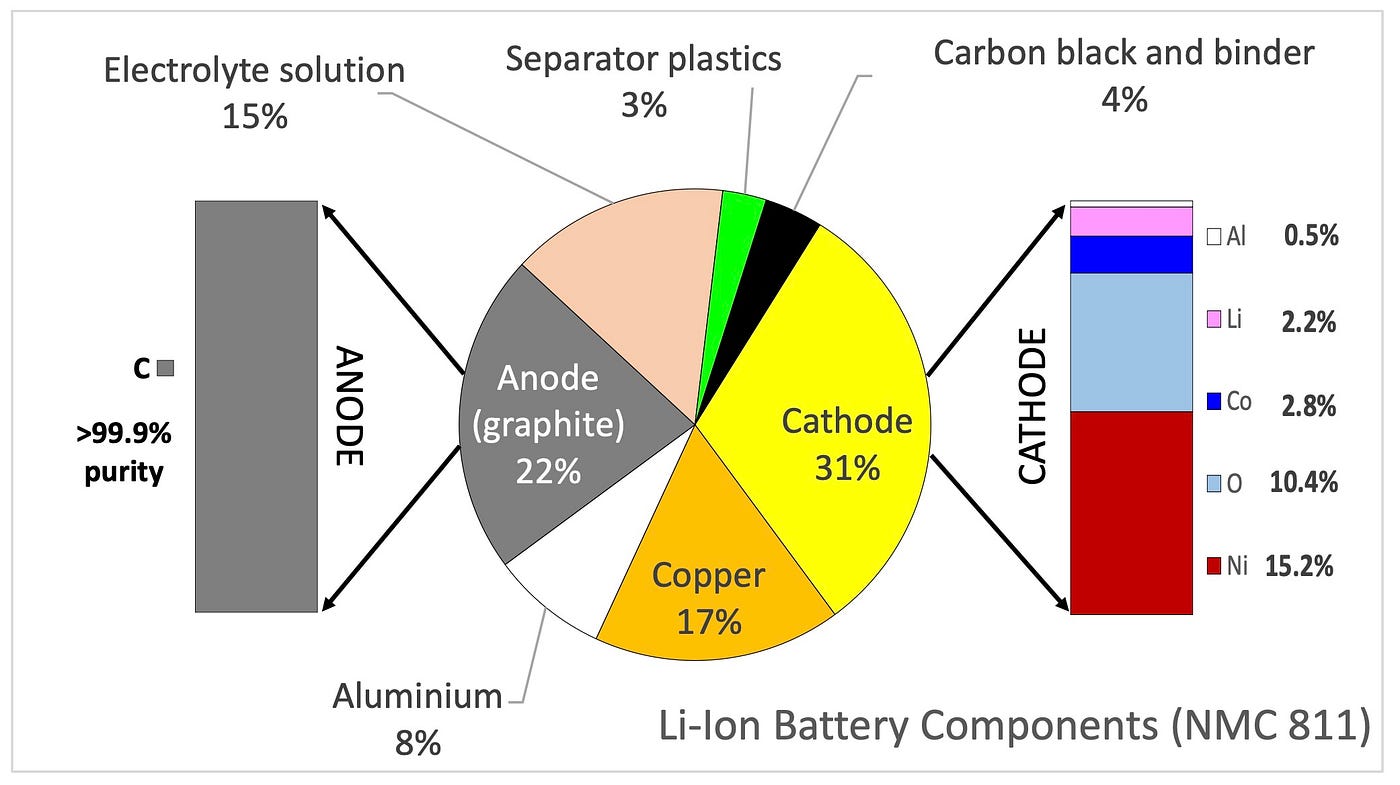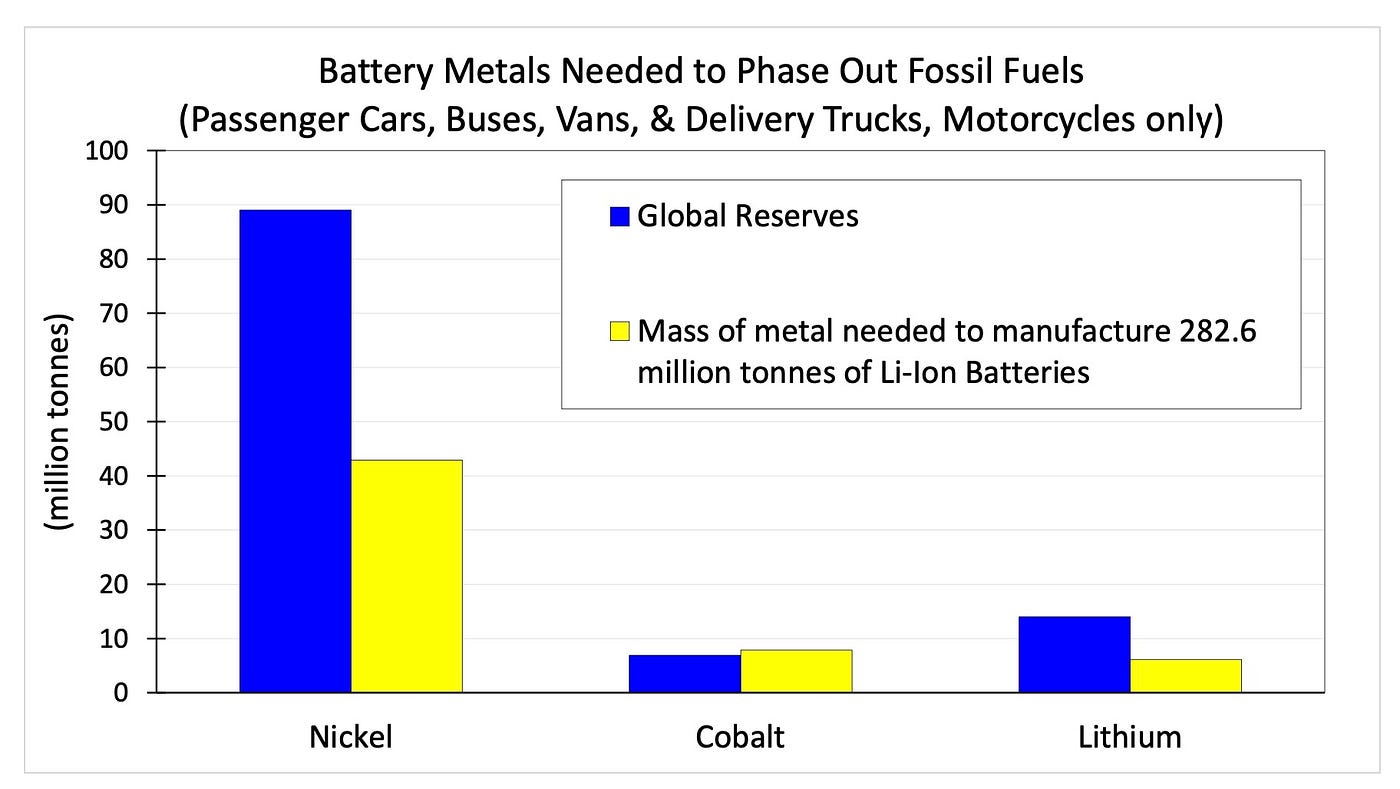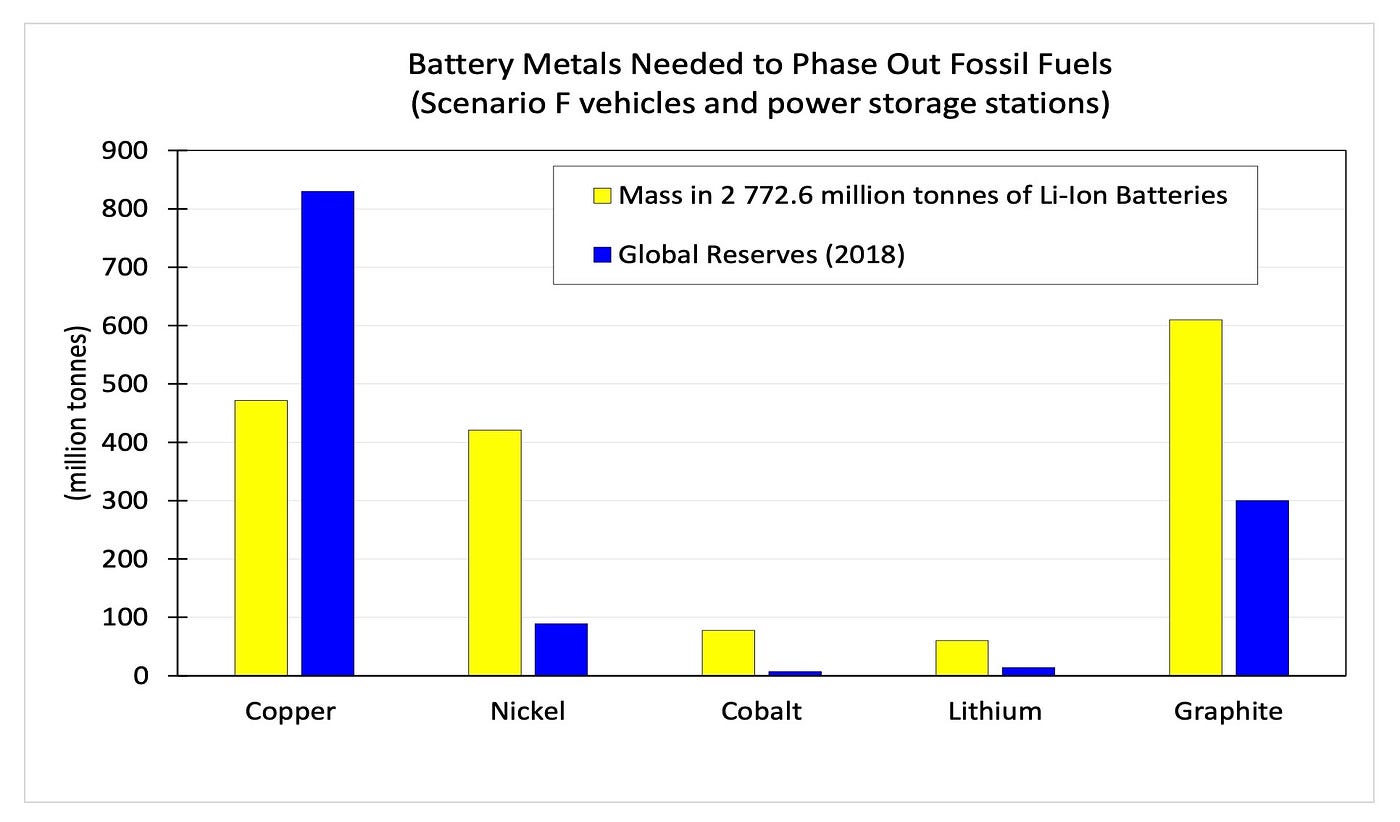How Electric Vehicles Won’t Save Us

One of the few pieces of ‘capital’ an ordinary human owns is a car. Given the planet-fuckery that capitalism has become, this is the most obvious thing to ‘fix’. Today we are relentlessly advertised electric vehicles as a solution, a transition that lets us have our cake and eat it too. The promise is that we can have everything we had with fossil fuels except better. But is it true?
In the long-run, as discussed, you simply cannot have infinite growth on a finite planet, whatever the energy source. Whether the earth’s critters get run over by a petrol car or an electric car is really just a timing difference. But nobody gives a fuck about the long-run, so let’s look at the short term view (this century). Can we transition to electric vehicles, and will this be a significant part of saving the Earth? That is to say, can we have our climate cake and personal, climate-controlled vehicles too?
The Numbers
In one giant 1,000 page document, Simon Michaux goes through the Assessment of the Extra Capacity Required of Alternative Energy Electrical Power Systems to Completely Replace Fossil Fuels. EVs are just one thing he covers and I cite extensively from this source (which contains it own sources) here.
The scope of the problem he lays out is replacing at least 1.416 billion vehicles, ie the rough vehicle population in 2016. Note that the vehicle population has only been growing and has to keep growing or ‘markets’ seize up and die. So this is low-balling it. The first hurdle is that every EV requires a battery, which requires minerals/materials. What materials? These ones:

This is the breakdown of just one type of Lithium Ion battery, but this gives us an approximate sense of the ‘default’ EV battery requires. So the first question is do we have enough of this (non-renewable) stuff to make electric vehicles. And the first answer is no.

To produce the about 1.5 billion EVs to replace our past fleet, we will need around 300 million tonnes of Lithium Ion batteries. This will require nearly 50% of known nickel reserves, ≈45% of known lithium, and 115% of known cobalt reserves. And bear in mind, this is only for one generation of vehicles. And these things wear out after 8–10 years. So we would have to use all the cobalt on Earth to buy one deprecation cycle. Unless we get hit by a cobalt asteroid, you can see that we’re already fucked. As Michaux says:
In theory, there are enough global reserves of nickel and lithium if they were exclusively used just to produce li-Ion batteries for vehicles. To make just one battery for each vehicle in the global transport fleet (excluding Class 8 HCV trucks), it would require 48.2% of 2018 global nickel reserves, and 43.8% of global lithium reserves (Source: USGS Mineral Statistics). There is not enough cobalt in current reserves to meet this demand and more will have to be discovered in exploration.
In practice, this will not work due to other demand application requirements, and that this represents only one generation of batteries of the current vehicle fleet. Every ten years from that point onwards, the same mass requirement would be needed all over again to produce the next generation of EV battery.
As you can see, this returns to the general mathematical principle of infinite growth on a finite planet. It simply does not compute, whatever raw material you input. To return to Sessi’s chessboard, you can put grains of rice, flakes of coal, or pellets of lithium on the board. If you keep growing anything exponentially, you are completely fucked in the long run. That’s why it’s funny seeing people herald the exponential adoption of EVs. That’s not a good thing.
To return to the proximate example, building the batteries is only one part of the problem. If you power an EV with fossil-fuel power plants then you still have the CO₂ problem. Hence for EVs to even have the illusion of green, you want to run them on solar/wind, which suffer from intermittency problems that need to be mitigated with battery storage. So you need battery back for your car batteries which means even more resource use.

This of course batters our poor Earth even more. We suddenly require nearly 50% of copper and graphite reserves, nearly 400% of the known nickel on Earth, and completely fanciful amounts of cobalt and lithium. It’s highly unlikely that there are just 4–8x known reserves out there, and if they were they’d quickly require more energy than it’s worth to extract (usually with diesel machinery). And again, this is only for one generation of a completely EV fleet.
But ‘recycling’ you might say. Since less than 1% of the current (total as of 2018) fleet is electric, you cannot get there with those materials, so this massive resource pull has to happen for just the first generation. At that point if you recycle anything less than 100% of the materials (which is impossible), you inevitably run out. There’s also no room for growth which capitalist society seizes up without. Recycling is just a timing difference on top of a timing difference. You meet your fate irregardless.
Hence the whole EV thing is not a civilization shift, it’s a joyride off a cliff. As a marketing-ploy, the idea that EVs will save the world is just deceit. The real problem is the same idea of growth and greed that remains in the driver’s seat. But I’m getting ahead of myself. Let’s get back to the math.
It important to note that Michaux doesn’t say anywhere that switching to EV vehicles isn’t possible. For all scenarios except airplane travel, we know how with current technology. The problem is that it’s not practical. I will reproduce his entire summary of the situation because, well, just read it:
It is concluded that all comparatively short-range transport is best done by an Electric Vehicle. This means that all passenger cars, commercial vans, delivery trucks and buses (1.39 billion vehicles), would travel 14.25 trillion km in a 365 day cycle. However, in order to do this, 65.19 TWh of batteries (282.6 million tonnes of Li-Ion batteries) will be required to be produced, and an annual additional 6 158.4 TWh of electricity will be required from the global power grid to charge those batteries.
Conversely, all long-range distance transport could be done with a hydrogen fuel cell powered vehicle. This suggests all Class 8 HCV trucks, the remainder of the rail transport network (including freight), and the whole maritime ship fleet, should be H2-cell powered. According to the calculations reported here, the global transport fleet comprises around 28.9 million Class 8 HCV trucks, which travelled 1.62 trillion km in the year 2018. If all of these trucks were to become hydrogen cell-powered and perform the same tasks, 130 million tonnes of hydrogen would be required annually, and 7 503.7 TWh of electricity required to produce that hydrogen. An estimated 18.5 million tonnes of hydrogen is needed to fuel just the rail transport fleet that is currently fossil fuel ICE powered (requiring 1 066.5 TWh of electricity to produce that H2). An estimated 51.7 million tonnes of hydrogen will be needed to fuel the global maritime fleet (requiring 2 983.4 TWh of electricity to produce that H2). In total, 200.1 million tonnes of hydrogen would be needed annually, and to make that hydrogen, 11 553.6 TWh of electricity of extra capacity is required.
A further 19 958.6 TWh of additional non-fossil fuel electrical power is required (part of Scenario B) to substitute for fossil fuel power generation (gas & coal), heating of buildings, and coal-fired steel manufacture. The grand total additional non-fossil fuel electrical power annual capacity to be added to the global grid was calculated to be an astonishing 37 670.6 TWh.
If the same non-fossil fuel energy mix as that reported in 2018 was assumed, then this translates into an extra 221 594 new power plants that would need to be constructed and commissioned. To put this in context, the total power plant fleet in 2018 (all types including fossil fuel plants) was only 46 423 stations.
Note that we’ve expanded the scope here from ‘cars’ to power generation and shipping, which are also important to life as we know it.
Future fanboys are found of saying we can ‘just’ switch from Internal Combustion Engines to electric and power long range stuff on hydrogen (not an energy source but storage) and that we have all the sun we need. Which is all true in the abstract. But let’s return to Earth, which is the problem. Can we use other non-renewable resources to continue this civilization? Fuck no. It’s just not minerally possible.
As I’ll say again and again, we cannot have our climate cake and eat it too. We must sacrifice and we must accept a reduction of human ambitions on a finite planet. The future simply won’t be like the car commercials, where you can save the world in lithium luxury comfort. Electric vehicles saving us from this mass extinction event is as farcical as warm blooded dinosaurs surviving theirs. It’s a much bigger problem and anybody telling you otherwise is as trustworthy as a the proverbial used car salesman. Do the math yourself. At best EVs give us an 8–10 lease on this car-driven civilization, and then it’s done. So please don’t @ me with hypotheticals or tell me about the infinite sun. In addition to our energetic problems, we’re minerally fucked. Find me another billion tons of cobalt (or whatever the mineral du jour is), show me how it's reproducing exponentially in the ground, and then we’ll talk.